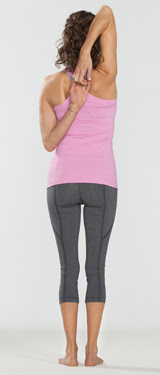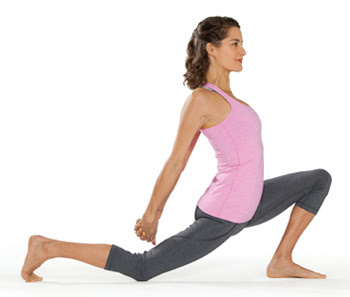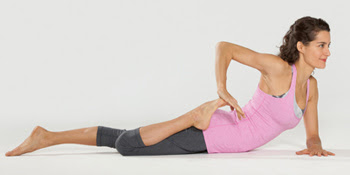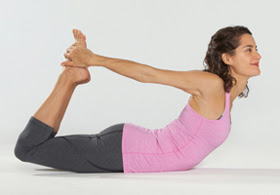This article touches on the plateau many of us reach at some point in our evolution as yogis. Over the years I’ve noticed how, just when things are getting ” interesting”, some students relegate yoga to a once a week pastime and start another physical activity instead. People heal and grow in their own time.
Yoga teaches us to face our fears with patience and an open heart. This courage-building backbend shows you how.

The victories and the challenges we encounter in our yoga practice become instructions for how to live more skillfully. In the first few years of practice, many people happily report that yoga has alleviated their anxiety, brought about increased feelings of well-being, and become a welcome respite from the stresses of everyday life. In this initial honeymoon phase, yoga offers a time-out from—and a soothing balm for—our difficulties.
But then sometimes a shift occurs in our practice and yoga takes us out of our comfort zone and catapults us into a much more challenging inner terrain that no longer feels like soothing relief. Our yoga becomes a source of tension instead, and we suddenly come face-to-face with the difficult and even scarier aspects of who we are and how we behave. We can easily lose heart and give up, believing that something is wrong with us—or with the type of yoga we’ve chosen—and decide that maybe we should just stop practicing altogether.
Yoga takes us out of our comfort zone and catapults us into a much more challenging inner terrain.
I believe, however, that the opposite is true; that we need to keep going. During this challenging phase, as our fears and flaws surface, we have a chance to work with those aspects of our personality that get in the way of knowing ourselves on a deeper level. For example, we may suddenly notice jealousy, anger, or fear arising, identify with it, and completely disregard the deeper truth that lives underneath the layers (or koshas) of our psychological conditioning and behavioral patterns. Like a set of Russian dolls, these koshas represent nesting layers of being, with experiences and truths existing at each level within us. So when we discover difficult truths about ourselves at one level, such as a tendency toward jealousy or fear, yoga reminds us that our experience at that moment does not represent the whole truth of who we are.
I call this stage of sadhana the yogic “fine print,” where we discover that direct lessons about faith will come through the doorway of doubt, where compassion is taught through pain, where true beauty is revealed only after facing what is ugly, and where courage is found in the dark recesses of what scares us most. The fine print of yogic practice shows us that these pairs of opposites inform one another in complementary and meaningful ways and that, as psychologist Carl Jung suggested many years ago, “The only way out is through.”
To go through rocky inner terrain requires courage in the face of fear, which reminds me of a teaching I received at a yoga teacher training years ago. Geeta Iyengar, B. K. S. Iyengar’s daughter, asked the group if they had any questions. One of the trainees asked, “What can we do when fear comes up for us or for our students during the practice?” Geeta replied, “When fear arises, you must lift your chest. You must lift your heart.”
The answer is great advice and holds insight for us on both a physical and an emotional level. Physically, when we get scared, our breath becomes shallow, our chest caves in, and our shoulders roll forward in an unconscious attempt to protect what feels vulnerable or afraid—the heart. Many times our hip flexors lock up on us as well. Fear has a posture.
Courage has a posture, too: a lifted chest, shoulder blades that sit firmly on the back, and a relaxed abdomen, all of which work in concert to strengthen the spine, stabilize the torso, elevate the emotions, and allow us to breathe more deeply, which helps reverse anxiety and fear-based tension.
Lifting our heart or seeking courage in the face of fear is a multifaceted journey.
As much as the word “posture” refers to our outer form, it pertains equally to our inner world. By working on the outer posture, the hatha practitioner gains access to his or her emotions and attitudes. When we act and look courageous, we begin to feel courageous, a yogic fake-it-til-you-make-it strategy. Of course, as with so many things in yoga, we must move slowly and patiently. We have established certain physical, mental, and emotional patterns that have become ingrained in us over a long period of time. In order to let these go and find newer, healthier expressions, we must create a mindful, respectful, and nurturing environment. I am reminded of the folk story about the farmer who was so excited about the plants in his field that he tugged on the tender sprouts to get them to grow faster and pulled them right out of the ground. Patience is as much a virtue as courage, as the old farmer discovered.
And so it is with patience and courage that we approach this month’s heart-opening, courage-building backbend, bhekasana. This posture requires that we lift the chest—challenging work for the shoulders and the front of the chest—while holding our legs stable in an intense quadriceps stretch. Physically, we need tremendous strength in our back and an equal amount of flexibility in our thighs, chest, and shoulders. Over time, with practice, the dynamic blend of strength and flexibility required for this posture can help us learn that lifting our heart or seeking courage in the face of fear is a demanding, challenging, and multifaceted journey.
Bhekasana requires a dynamic blend of strength and flexibility.
Plan to practice the poses in this sequence more than several times as they’ll become easier with repetition. Begin your practice session with several rounds of sun salutations and some standing poses such as parshvakonasana (side angle pose), trikonasana (triangle pose), and virabhadrasana 1 (warrior 1 pose) to help you warm up by activating your legs and stretching your spine. In your opening postures, focus on actively pushing or rooting your legs downward into the floor to encourage a corresponding lift through your torso and spine. By stretching your spine in this way, your body will be ready to do the more specific work of shoulder and quadriceps stretching that this sequence emphasizes and that bhekasana requires.
Preparation
1. Parvatasana (Mountain Pose)
 Stand in tadasana and interlace your hands behind your back. As you inhale, firm the muscles of your legs and lift your chest. Keeping your elbows slightly bent behind you, firm your shoulder blades on your back and take your arm bones toward the back plane of your body until you feel a strong stretch along the front of your chest and shoulders.
Stand in tadasana and interlace your hands behind your back. As you inhale, firm the muscles of your legs and lift your chest. Keeping your elbows slightly bent behind you, firm your shoulder blades on your back and take your arm bones toward the back plane of your body until you feel a strong stretch along the front of your chest and shoulders.
This intense stretch for the shoulders often creates a “swayback” position in the lumbar spine. To counteract this tendency, move your side ribs toward the back plane of the body, scoop your tailbone into your body, and lift your low belly from the pubic bone to the navel to create tone in your abdomen and support for your spine. Hold the posture for 5 to 10 breaths. Release, change the hand clasp so the opposite forefinger is on top, and repeat.
2. Parvatasana Gomukhasana (Mountain Pose with Cow Face Arms)
 Stand in tadasana. If the fronts of your shoulders are very tight, place a strap over your right shoulder. Stretch your left arm out to the side, parallel with the floor, at shoulder height. Bend your elbow and place your left hand on your right shoulder blade, with the top of your hand directly on the blade and your palm facing the wall behind you. If you are using a strap, place it in your left hand.
Stand in tadasana. If the fronts of your shoulders are very tight, place a strap over your right shoulder. Stretch your left arm out to the side, parallel with the floor, at shoulder height. Bend your elbow and place your left hand on your right shoulder blade, with the top of your hand directly on the blade and your palm facing the wall behind you. If you are using a strap, place it in your left hand.
Lift your right arm directly out in front of you until it is parallel with the floor at shoulder height. Inhale deeply and lift your chest fully. Keeping the lift in your chest, move the head of your arm bone deeper into your shoulder socket. Exhale. With your next inhalation, bring your arm overhead. Bend your right arm and grab hold of the strap or clasp your left hand with your right hand. Breathe deeply and hold the posture for 5 to 10 breaths. Release the clasp and repeat on the other side.
3. Anjaneyasana Variation (Crescent Moon Pose with Clasped Hands)
 Begin in a low lunge with your right knee on the floor. Inhale, place your hands on your front thigh, and bring your torso to a vertical position. To stabilize your torso, exhale and bring your chin to your chest for a moment. Push your hands gently into your front leg, slide your side ribs back, and lift your low belly. Maintaining that tone, lift your chin slightly until your neck rests in a natural curve.
Begin in a low lunge with your right knee on the floor. Inhale, place your hands on your front thigh, and bring your torso to a vertical position. To stabilize your torso, exhale and bring your chin to your chest for a moment. Push your hands gently into your front leg, slide your side ribs back, and lift your low belly. Maintaining that tone, lift your chin slightly until your neck rests in a natural curve.
Next, interlace your hands behind your back, broaden your elbows to the sides, inhale, and lift your chest courageously. Bring your shoulder blades toward one another on your back, move the heads of your arm bones to the back plane of your body, and stretch your chest and shoulders. If your back is strong, you can deepen this posture by creating an upper back backbend or a “coiling” action in your upper back. In order to do this safely, squeeze your legs until you feel your inner thighs engage, root your back knee firmly into the floor, and keep the abdominal-tailbone area strong. Lift your collarbones and upper chest toward the ceiling, and if your neck will allow it, gently take the head back and lift your eyes toward the ceiling. Otherwise, keep your gaze forward. Hold for 5 breaths. Remember, cultivating courage and confidence takes time. Release and repeat on the other side.
4. Eka Pada Bhekasana (One-Legged Frog Pose)
 Lie on your belly. Place your left forearm on the floor, parallel to the front edge of your mat. Bend your right knee and point your toes toward the ceiling. Stretch your right arm out in front of you and stick your thumb in the air as though you are hitchhiking. Then reach your hand back and grab hold of your foot’s inner arch. Keep your thumb on your inner arch and bend your right elbow slightly out to the side. Inhale fully. Keep your belly strong and your tailbone engaged. Lift your chest, lift your shoulder toward your ear, move your arm bone back, turn your forearm in toward your body, and wrap your hand around the top of your foot. Hold the posture for 5 to 10 breaths and then release and repeat on the other side.
Lie on your belly. Place your left forearm on the floor, parallel to the front edge of your mat. Bend your right knee and point your toes toward the ceiling. Stretch your right arm out in front of you and stick your thumb in the air as though you are hitchhiking. Then reach your hand back and grab hold of your foot’s inner arch. Keep your thumb on your inner arch and bend your right elbow slightly out to the side. Inhale fully. Keep your belly strong and your tailbone engaged. Lift your chest, lift your shoulder toward your ear, move your arm bone back, turn your forearm in toward your body, and wrap your hand around the top of your foot. Hold the posture for 5 to 10 breaths and then release and repeat on the other side.
5. Anjaneyasana Variation (Crescent Moon Pose with Thigh Stretch)
 From anjaneyasana, place your left hand on your left thigh. Bend your right knee and take hold of your foot. This posture is a very deep quadriceps stretch so make sure to activate your legs, lift your chest, and keep your core abdominal muscles engaged. If you have difficulty bringing your foot to your hip, try this: Bend slightly forward at your hips. Stick your buttock out and bring it back to your foot. Now close the joint of your knee and bring your heel to your hip. Keeping your hip and your heel joined, move back into the form of the pose, bringing your pelvis forward and your left sitting bone closer toward your left heel. The torso will sometimes turn toward the back leg. In order to square your hips and optimally align your torso, draw your right ribs toward your left knee until both hips and both shoulders face forward. Hold for 5 breaths. Release and repeat on the other side.
From anjaneyasana, place your left hand on your left thigh. Bend your right knee and take hold of your foot. This posture is a very deep quadriceps stretch so make sure to activate your legs, lift your chest, and keep your core abdominal muscles engaged. If you have difficulty bringing your foot to your hip, try this: Bend slightly forward at your hips. Stick your buttock out and bring it back to your foot. Now close the joint of your knee and bring your heel to your hip. Keeping your hip and your heel joined, move back into the form of the pose, bringing your pelvis forward and your left sitting bone closer toward your left heel. The torso will sometimes turn toward the back leg. In order to square your hips and optimally align your torso, draw your right ribs toward your left knee until both hips and both shoulders face forward. Hold for 5 breaths. Release and repeat on the other side.
6. Shalabhasana (Locust Pose)
 Lie on your belly. Bring your legs together and the inside edges of your feet together. Squeeze the muscles of your legs firmly to tone your legs. Inhale fully, squeezing your shoulders firmly toward one another. Lift your torso and legs up and away from the floor until you are balancing only on your abdomen. To get higher, separate your legs hip-distance apart, inhale, and lift your chest and legs higher. Maintain that new height and rejoin your legs. Hold for 5 breaths. Lower slowly. Rest.
Lie on your belly. Bring your legs together and the inside edges of your feet together. Squeeze the muscles of your legs firmly to tone your legs. Inhale fully, squeezing your shoulders firmly toward one another. Lift your torso and legs up and away from the floor until you are balancing only on your abdomen. To get higher, separate your legs hip-distance apart, inhale, and lift your chest and legs higher. Maintain that new height and rejoin your legs. Hold for 5 breaths. Lower slowly. Rest.
7. Shalabhasana 2 (Locust Pose 2)
 Lie down on your belly with your arms by your sides, palms face up. Bend your knees until your shins are perpendicular to the floor; your legs should be about six inches apart. Keeping your fingers in contact with the floor, inhale fully and create length along the sides of your torso. Move the heads of your arm bones back and your shoulder blades toward each other. Inhale and lift your torso and legs as far off the floor as possible. Lift your thighs, lower ribs, and chin and hold this position for 5 full breaths.
Lie down on your belly with your arms by your sides, palms face up. Bend your knees until your shins are perpendicular to the floor; your legs should be about six inches apart. Keeping your fingers in contact with the floor, inhale fully and create length along the sides of your torso. Move the heads of your arm bones back and your shoulder blades toward each other. Inhale and lift your torso and legs as far off the floor as possible. Lift your thighs, lower ribs, and chin and hold this position for 5 full breaths.
8. Dhanurasana (Bow Pose)
 Lying on your belly, bend your knees, reach your arms behind you, and clasp the tops of your feet. Point your toes toward the ceiling. Inhale, move your arm bones back, and lift your lower ribs and thighs off the floor. Squeeze your legs toward one another to prevent the knees from splaying, kick your legs back into your hands, tone the muscles in your buttocks to lift your legs more, and with great persistence and tenacity, lift your chest as high off the floor as you can, balancing your weight on your belly.
Lying on your belly, bend your knees, reach your arms behind you, and clasp the tops of your feet. Point your toes toward the ceiling. Inhale, move your arm bones back, and lift your lower ribs and thighs off the floor. Squeeze your legs toward one another to prevent the knees from splaying, kick your legs back into your hands, tone the muscles in your buttocks to lift your legs more, and with great persistence and tenacity, lift your chest as high off the floor as you can, balancing your weight on your belly.
9. Ardha Bhekasana/Ardha Dhanur-asana (Half Frog/Half Bow Pose)
 Much like courage develops in the face of fear, and confidence grows in our moments of insecurity, the strength we need for bhekasana comes through the very challenge of the posture itself, this lift against gravity. From dhanurasana, increase your efforts to lift your chest. Continue kicking your right leg into your right hand, bend your left knee, turn your left forearm in toward your body, pivoting on the heel of your left hand in order to clasp your hand around your toes. Hold for 5 breaths. Return your left hand to your foot for danurasana, lift your chest again, and repeat the instructions on the other side, bringing your right foot into bhekasana. After completing 5 breaths with your right leg folded in, return to dhanurasana before releasing and resting. It requires tremendous endurance to maintain good alignment, so rest between sides if you need to.
Much like courage develops in the face of fear, and confidence grows in our moments of insecurity, the strength we need for bhekasana comes through the very challenge of the posture itself, this lift against gravity. From dhanurasana, increase your efforts to lift your chest. Continue kicking your right leg into your right hand, bend your left knee, turn your left forearm in toward your body, pivoting on the heel of your left hand in order to clasp your hand around your toes. Hold for 5 breaths. Return your left hand to your foot for danurasana, lift your chest again, and repeat the instructions on the other side, bringing your right foot into bhekasana. After completing 5 breaths with your right leg folded in, return to dhanurasana before releasing and resting. It requires tremendous endurance to maintain good alignment, so rest between sides if you need to.
The Peak Pose
10. Bhekasana (Frog Pose)
 Lying on your belly, reach back and grab your feet as though you were going to do dhanurasana. Inhale, lift your chest as high as you can and squeeze your shoulders toward one another. Maintain the lift of your torso and keep your arm bones back while you fold your feet into your hips and rotate your hands around the tops of your feet until they face forward. If you are new to the pose, fold your legs in one at a time. The higher you lift your chest, the easier it is to fold your legs into the shape of the posture. Hold for 5 breaths and then slowly release the posture, and relax.
Lying on your belly, reach back and grab your feet as though you were going to do dhanurasana. Inhale, lift your chest as high as you can and squeeze your shoulders toward one another. Maintain the lift of your torso and keep your arm bones back while you fold your feet into your hips and rotate your hands around the tops of your feet until they face forward. If you are new to the pose, fold your legs in one at a time. The higher you lift your chest, the easier it is to fold your legs into the shape of the posture. Hold for 5 breaths and then slowly release the posture, and relax.
End your practice with adho mukha shvanasana (downward-facing dog), a few simple reclining twists, supta padangusthasana (reclining big toe pose) and uttanasana (standing forward bend pose). Sarvangasana (shoulderstand) or viparita karani (legs-up-the-wall pose) would further complement this sequence. Take time to relax and integrate your efforts with a long shavasana. It is important to balance strong effort with periods of rest, relaxation, and rejuvenation so that your practice is balanced and you give yourself a chance to experience the variety of moods, feelings, and insights that accompany the inner journey of asana.
 ABOUT Christina Sell Christina Sell has been teaching yoga since 1998 and is the author of Yoga from the Inside Out and My Body Is a Temple.
ABOUT Christina Sell Christina Sell has been teaching yoga since 1998 and is the author of Yoga from the Inside Out and My Body Is a Temple.
source http://yogainternational.com/
